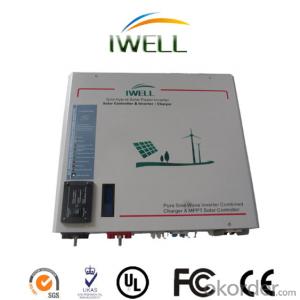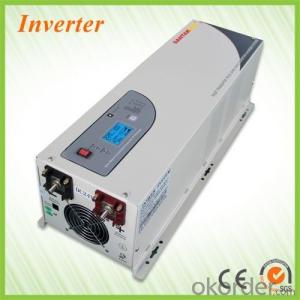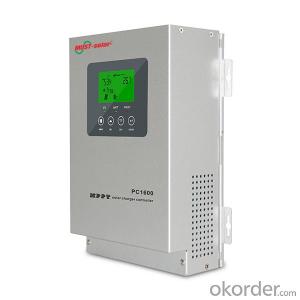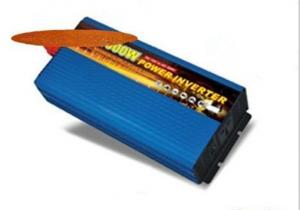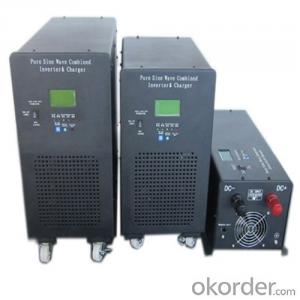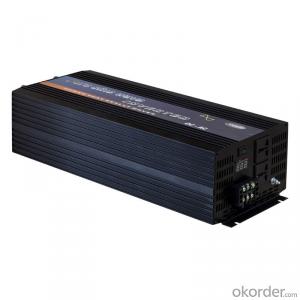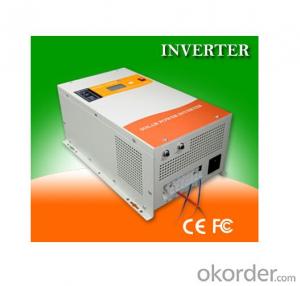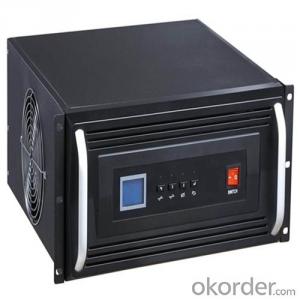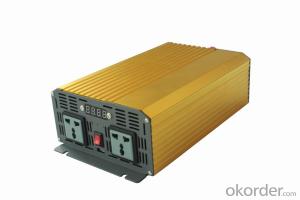400V Solar Inverter 12V 24V 1-3KW Pure Sine Wave Inverter with Controller and Charger
- Loading Port:
- Qingdao
- Payment Terms:
- TT or LC
- Min Order Qty:
- 50 unit
- Supply Capability:
- 3000 unit/month
OKorder Service Pledge
OKorder Financial Service
You Might Also Like
1. Structure of Solar System 12V 24V 1-3KW Inverter with Controller and Charger Pure Sine Wave
A solar inverter, or PV inverter, or Solar converter, converts the variable direct current (DC) output of a photovoltaic (PV) solar panel into a utility frequency alternating current (AC) that can be fed into a commercial electrical grid or used by a local, off-grid electrical network.
It is a critical BOS–component in a photovoltaic system, allowing the use of ordinary AC-powered equipment.
Solar inverters have special functions adapted for use with photovoltaic arrays, including maximum power point tracking and anti-islanding protection.
2. Main Features of the Solar System 12V 24V 1-3KW Inverter with Controller and Charger Pure Sine Wave
﹒Output waveform: pure sine wave
﹒High efficiency>85%
﹒12v or24v or 48vDC input
﹒AC100V or AC110V or AC120V/220v /230V /240V AC output
﹒Output frequency 60HZ or 50HZ
﹒Continuous output power:10KW
﹒High-velocity cooling fan
﹒Overload protect ,over voltage protect ,low voltage cut-out ,low voltage alarm
3. Solar System 12V 24V 1-3KW Inverter with Controller and Charger Pure Sine Wave Images

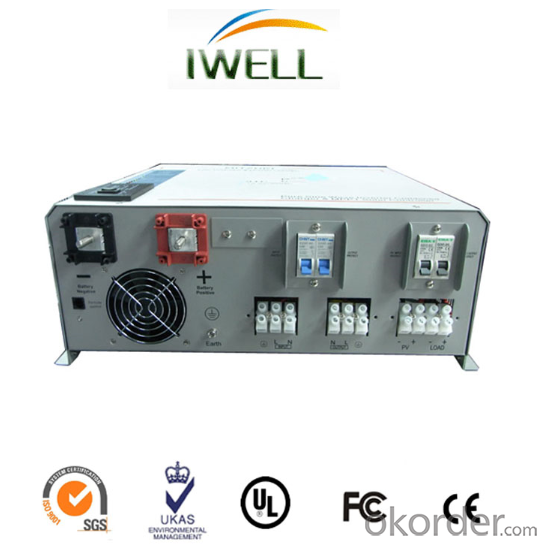
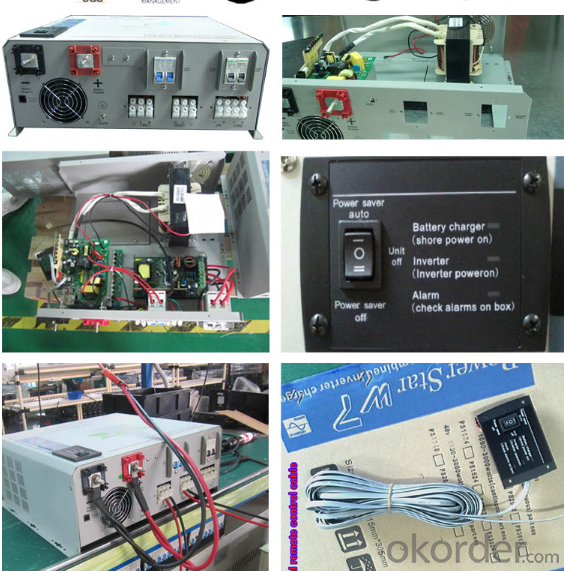
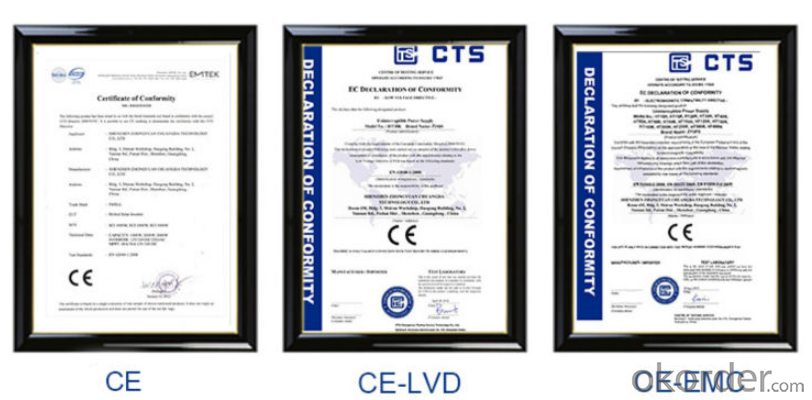
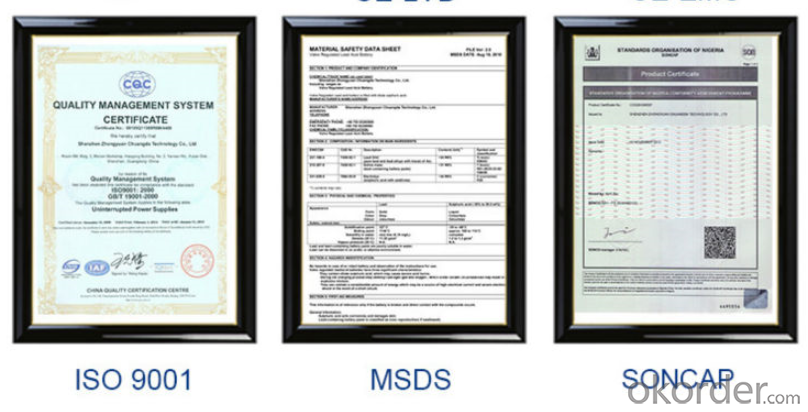
4. Solar System 12V 24V 1-3KW Inverter with Controller and Charger Pure Sine Wave Specification
Mode | PTV 500W | PTV 1000W | PTV 1500W | PTV 2000 | PTV 3000 |
Continuous power (W) | 500W | 1000W | 1500W | 2000W | 3000W |
Surge capability (W) | 1500W | 3000W | 4500W | 6000W | 6000W |
System DC input (VDC) | 12VDC | 24VDCV | 24VDC | 24VDC | 24VDC |
AC Output | 110 / 120V/ 220V/230V ±5% , 50HZ or 60HZ. Terminal | ||||
AC Output waveform | Pure Sine Wave | ||||
DC output | 12VDC or 24VDC Terminal | ||||
Efficiency | 88% | ||||
AC/DC Charger | Max 15A | Max 25A | Max 25A | Max 40AMP | Max 50 |
Solar Charge Controller | MPPT,20AMP | MPPT,30AMP | MPPT,40AMP | MPPT,50AMP | MPPT 100AMP |
Adviced PV | 36 or 72 Cell | 72 Cell | 72 Cell | 72 Cell | 72 Cell |
External battery back | 12 or 24VDC | 24VDC | 24VDC | 24VDC | 24VDC |
Breakers | with Breakers for AC Input , AC output, PV input , DC output | ||||
Battery low protection | yes | ||||
Over discharge protection | yes | ||||
Resume voltage | yes. When fault remove | ||||
Over voltage protection | yes | ||||
Overload protection | yes. | ||||
With cooling fan | yes | ||||
Display | LED for Inverter,charger,Battery Capacity state, DC load state and fault. LCD display is optional | ||||
Running Temperature | -35 degree to 55 degree | ||||
High temperature protection | YES | ||||
Short circuit protection | YES | ||||
Reverse polarity protection | YES. Only for DC load side. | ||||
Stand by | yes. continou ouput while > 25W | ||||
Communication | RS232 Power Manager, NetAgent SNMP , Optional for LED mode | ||||
Package Size(mm) | 608*558*293 | 608*558*293 | 608*558*293 | 608*558*293 | 608*558*293 |
Gross Weight KG | 21 | 24 | 24 | 26 | 32 |
product Size (mm) | 460*440*200 | 460*440*200 | 460*440*200 | 460*440*200 | 460*440*200 |
product weight( kg) | 15KG | 16KG | 16KG | 19.5KG | 24KG |
5. FAQ of Solar System 12V 24V 1-3KW Inverter with Controller and Charger Pure Sine Wave
Q1. What is the difference between inverter and solar inverter?
A1. Inverter only has AC inpput, but solar inverter both connect to AC input and solar panel, it saves more power.
Q2. What is the difference between MPPT&PWM?
A2. MPPT has higher efficiency, it can track the max power point and won't waste energy.
Q3. What is the waranty of product?
A3. 12 months.
- Q: How does a solar inverter handle overloading?
- A solar inverter handles overloading by constantly monitoring the power output from the solar panels. If the demand for electricity exceeds the maximum capacity of the inverter, it automatically reduces the power output to a safe level. This prevents the inverter from getting damaged and ensures a stable and reliable power supply.
- Q: How does a solar inverter handle voltage regulation in the grid?
- A solar inverter regulates voltage in the grid by converting the DC power generated by the solar panels into AC power that matches the voltage and frequency of the grid. It monitors the grid's voltage level and adjusts the output accordingly to ensure a stable and consistent supply of power. Additionally, it also helps in maintaining power quality by maintaining the grid's voltage within the specified range and compensating for fluctuations or variations in voltage levels.
- Q: Can a solar inverter be used for both single-phase and three-phase applications?
- No, a solar inverter cannot be used for both single-phase and three-phase applications. Different types of inverters are designed specifically for either single-phase or three-phase systems, as they have different voltage and power requirements.
- Q: How does the input current rating affect the performance of a solar inverter?
- The input current rating of a solar inverter directly affects its performance as it determines the maximum amount of current that the inverter can handle from the solar panels. If the input current rating is too low, it may not be able to handle the full power output of the solar panels, leading to inefficiency and potential damage to the inverter. On the other hand, if the input current rating is too high, it may be overkill for the system, resulting in unnecessary costs. Therefore, selecting an appropriate input current rating is crucial for optimal performance and longevity of a solar inverter.
- Q: How does a solar inverter handle voltage unbalance in the grid?
- A solar inverter handles voltage unbalance in the grid by continuously monitoring the incoming voltage levels. If it detects a voltage imbalance, it automatically adjusts its internal control mechanisms to balance the output voltage and ensure stable operation. Additionally, the inverter may also employ advanced algorithms to mitigate the effects of voltage unbalance, such as reactive power compensation and voltage regulation, minimizing any potential impacts on the solar system's performance and the grid.
- Q: How does a solar inverter handle voltage and frequency variations caused by load shedding?
- Load shedding causes voltage and frequency variations, which a solar inverter can handle through its built-in mechanisms and control systems. When these variations occur, the inverter detects them and adjusts its operation accordingly. To handle voltage variations, the inverter employs a voltage regulation system. It continuously monitors the grid voltage and compares it with the standard level. If the grid voltage goes beyond the acceptable range, the inverter adjusts its internal voltage conversion process to maintain a stable output voltage. This ensures that the solar panels generate power within the acceptable voltage limits, minimizing negative effects from voltage fluctuations. Similarly, for frequency variations caused by load shedding, the inverter has a frequency regulation mechanism. It monitors the grid frequency and compares it with the standard level. If there are frequency deviations, the inverter adjusts its internal synchronization process to match the grid frequency. This allows the inverter to synchronize with the grid and feed the generated solar power in a way that is compatible with the grid's frequency. Apart from voltage and frequency regulation, solar inverters often have additional functionalities to enhance their ability to handle load shedding variations. These can include anti-islanding protection, which disconnects the solar system from the grid during a power outage to protect utility workers. Some advanced inverters also have energy storage capabilities, allowing them to store excess solar energy and provide uninterrupted power during load shedding events. Overall, solar inverters are specifically designed to handle voltage and frequency variations caused by load shedding. Through their regulation and control systems, they ensure that the solar power generated remains stable and compatible with the grid, providing a reliable and efficient power supply even in challenging grid conditions.
- Q: What are the key safety features to look for in a solar inverter?
- The key safety features to look for in a solar inverter include overvoltage protection, ground fault protection, arc fault protection, and rapid shutdown capability. These features help ensure the safe and efficient operation of the solar system, protecting against electrical hazards and reducing the risk of fire or injury.
- Q: What is the role of a galvanic isolation circuit in a solar inverter?
- The role of a galvanic isolation circuit in a solar inverter is to provide electrical safety by preventing the flow of direct current (DC) between the solar panels and the alternating current (AC) grid. It isolates the input and output sides of the inverter, protecting the user and the equipment from potential hazards such as electrical shocks and short circuits. Additionally, it helps in reducing noise and improving the overall performance and efficiency of the solar inverter system.
- Q: What is the maximum output voltage of a solar inverter?
- The maximum output voltage of a solar inverter depends on various factors such as the inverter model, design, and specifications. However, in general, the maximum output voltage of a solar inverter is typically around 230-240 volts for residential or commercial applications.
- Q: What is the role of a solar inverter in a grid-independent system?
- The role of a solar inverter in a grid-independent system is to convert the direct current (DC) generated by the solar panels into alternating current (AC) that can be used to power household appliances and other electrical loads. It also manages the flow of electricity between the solar panels, batteries (if present), and the electrical loads, ensuring optimal energy utilization and system efficiency. Additionally, a solar inverter in a grid-independent system may incorporate advanced features like battery charging and discharging control, voltage regulation, and monitoring capabilities to ensure the stability and reliability of the system.
Send your message to us
400V Solar Inverter 12V 24V 1-3KW Pure Sine Wave Inverter with Controller and Charger
- Loading Port:
- Qingdao
- Payment Terms:
- TT or LC
- Min Order Qty:
- 50 unit
- Supply Capability:
- 3000 unit/month
OKorder Service Pledge
OKorder Financial Service
Similar products
Hot products
Hot Searches
Related keywords
